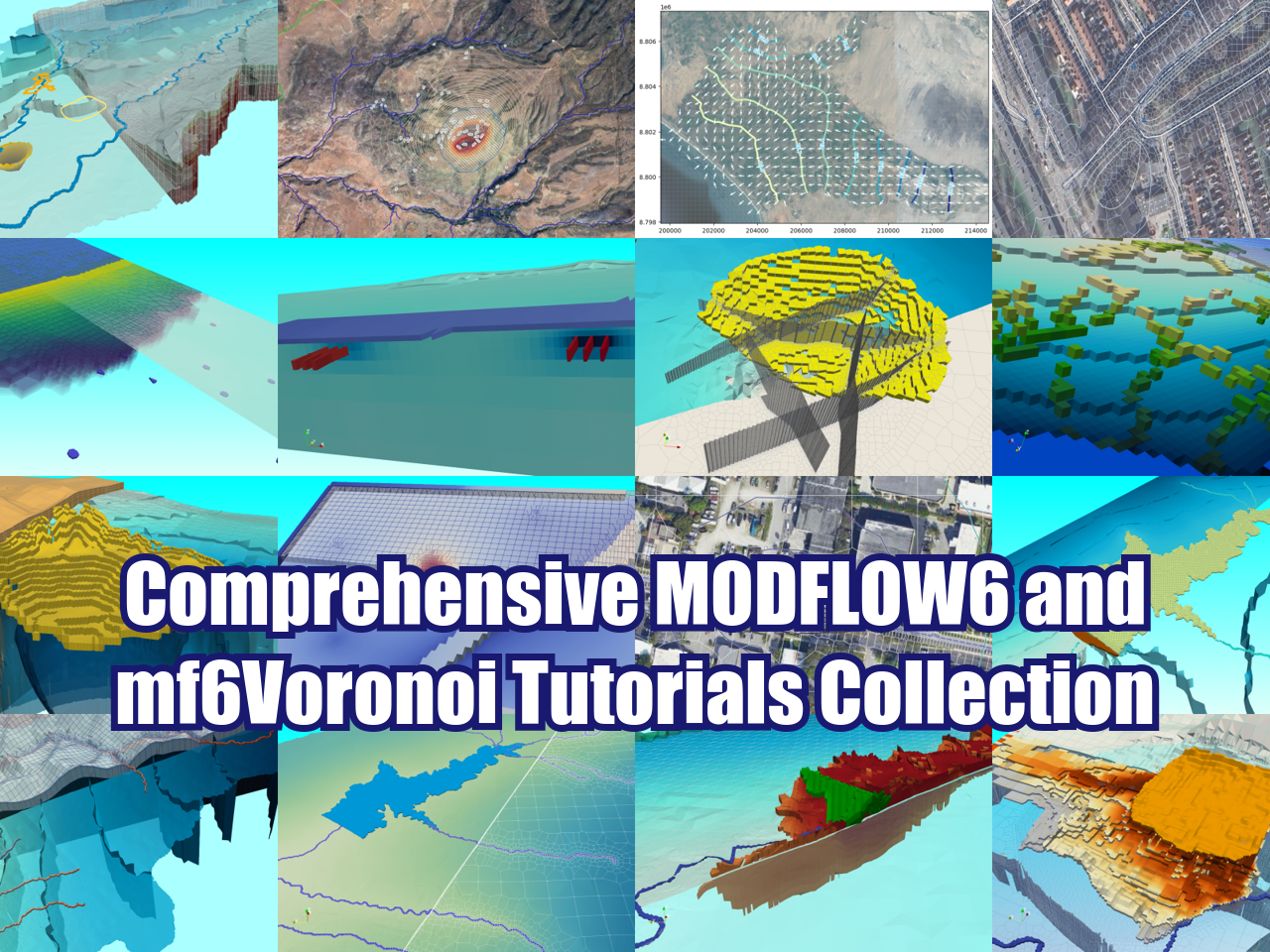2D Contaminant Transport Modeling with MODFLOW, MT3D-USGS and Flopy
/Making hydrogeological models can take a long time, from construction, visualization of results and calibration. It is important to use tools that can optimize these tasks and allow the time saved to be used in the analysis of the system.
In this opportunity we will use Flopy to replicate a 2D transport model from a previous post (https://www.hatarilabs.com/ih-en/two-dimensional-transport-modeling-in-a-radial-flow-field-with-modflow-and-mt3dms). Flopy is a versatile set of Python scripts which can be used to run MODFLOW and MT3D, amongst other MODFLOW-related groundwater programs in a simple and efficient way. It will be seen how useful this tool is to automate the process of creating groundwater models since modifications of the boundary conditions can be done just by changing the text file.
In addition, MT3D-USGS will be used for the transport modelling. It is an updated release of the groundwater solute transport code MT3DMS, which has new transport modeling capabilities that provide a greater flexibility in the simulation of solute transport and reactive solute transport.
Tutorial
Input code
This is the complete code for the groundwater model in Flopy:
#Import
%matplotlib inline
import numpy as np
import matplotlib.pyplot as plt
import flopy
import flopy.modflow as mf
import flopy.mt3d as mt
import flopy.utils as fu#MODFLOW 2005
modelname = 'example'
mf_model = mf.Modflow(modelname = modelname, exe_name='mf2005.exe')#DIS file
Lx = 310
Ly = 310
nrow = 31
ncol = 31
nlay = 1
delr = Lx / ncol
delc = Ly / nrow
top = np.ones((nrow, ncol))
botm = np.zeros((nrow, ncol))
perlen = 27
dis = mf.ModflowDis(mf_model, nlay, nrow, ncol, delr = delr, delc = delc,
top = top, botm = botm, laycbd = 0, itmuni=4, perlen = perlen,
nstp = 1)# Output Control: Create a flopy output control object
oc = mf.ModflowOc(mf_model)#BCF file
laycon=0 #confined
tran=1.0 #transmissivity
bcf = flopy.modflow.mfbcf.ModflowBcf(mf_model,laycon=0, tran=1.0)#BAS file
ibound = np.ones((nlay, nrow, ncol)) #active
ibound[0, 0, :31] = -1 #constant head
ibound[0, 30, :31] = -1
ibound[0, :31, 0] = -1
ibound[0, :31, 30] = -1
strt=15 #starting head
iboundbas = mf.ModflowBas(mf_model, ibound = ibound, strt = strt)#PCG file
pcg = flopy.modflow.mfpcg.ModflowPcg(mf_model, mxiter=20, iter1=30, hclose=1e-03, rclose=1e-03, relax=1.0)#CHD
#[lay, row, col, shead, ehead]
chd=15
chd_data = []
for c in range(30):
dd = np.array([0, 0, c, chd, chd])
chd_data.append(dd)
for c in range(31):
dd = np.array([0, c, 30, chd, chd])
chd_data.append(dd)
for c in range(30):
dd = np.array([0, 30, c, chd, chd])
chd_data.append(dd)
for c in range(1,30):
dd = np.array([0, c, 0, chd, chd])
chd_data.append(dd)
stress_period_data = {0:chd_data}
stress_period_datachd = mf.mfchd.ModflowChd(mf_model, stress_period_data=stress_period_data)#WELL
#[lay, row, col, pumping rate]
pumping_rate = 100 #m3/d
wel_sp1 = [[0, 15, 15, pumping_rate]]
stress_period_data = {0: wel_sp1}
wel = flopy.modflow.ModflowWel(mf_model, stress_period_data=stress_period_data)#LMT Linkage with MT3DMS for multi-species mass transport modeling
lmt = flopy.modflow.ModflowLmt(mf_model, output_file_name='mt3d_link.ftl')#Write input files
mf_model.write_input()
# run the model
mf_model.run_model()#Plot model results
import matplotlib.pyplot as plt
import flopy.utils.binaryfile as bf
# Create the headfile object
headobj = bf.HeadFile(modelname+'.hds')
head = headobj.get_data(totim=27)
times = headobj.get_times()
# Setup contour parameters
levels = np.arange(0, 90, 5)
extent = (delr/2., Lx - delr/2., delc/2., Ly - delc/2.)
# Make the plots
plt.subplot(1, 1, 1, aspect='equal')
plt.title('Head distribution (m)')
plt.imshow(head[0, :, :], extent=extent, cmap='YlGnBu', vmin=0., vmax=90.)
plt.colorbar()
contours = plt.contour(np.flipud(head[0, :, :]), levels=levels, extent=extent, zorder=10)
plt.clabel(contours, inline=1, fontsize=10, fmt='%d', zorder=11)
plt.show()#MT3D-USGS
namemt3d='modelnamemt3d'
mt_model = mt.Mt3dms(modelname=namemt3d, version='mt3d-usgs', exe_name='MT3D-USGS_64.exe', modflowmodel=mf_model)#BTN file
icbund = np.ones((nlay, nrow, ncol))
icbund[0, 15, 15] = -1 #constant concentration
btn = flopy.mt3d.Mt3dBtn(mt_model, sconc=0.0, prsity=0.3, thkmin=0.01, munit='g', icbund=icbund)#ADV file
mixelm = -1 #Third-order TVD scheme (ULTIMATE)
percel = 1 #Courant number PERCEL is also a stability constraint
adv = flopy.mt3d.Mt3dAdv(mt_model, mixelm=mixelm, percel=percel)#GCG file
mxiter = 1 #Maximum number of outer iterations
iter1 = 200 #Maximum number of inner iterations
isolve = 3 #Preconditioner = Modified Incomplete Cholesky
gcg = flopy.mt3d.Mt3dGcg(mt_model, mxiter=mxiter, iter1=iter1, isolve=isolve)#DSP file
al = 10 #longitudinal dispersivity
dmcoef = 0 #effective molecular diffusion coefficient
trpt = 0.1 #ratio of the horizontal transverse dispersivity to the longitudinal dispersivity
trpv = 0.01 #ratio of the vertical transverse dispersivity to the longitudinal dispersivity
dsp = mt.Mt3dDsp(mt_model, al=al, dmcoef=dmcoef, trpt=trpt, trpv=trpv)#SSM file
itype = flopy.mt3d.Mt3dSsm.itype_dict()
#[K,I,J,CSS,iSSType] = layer, row, column, source concentration, type of sink/source: well-constant concentration cell
ssm_data = {}
ssm_data[0] = [(0, 15, 15, 1.0, 2)]
ssm_data[0].append((0, 15, 15, 1.0, -1))
ssm = flopy.mt3d.Mt3dSsm(mt_model, stress_period_data=ssm_data)#Write model input
mt_model.write_input()
#Run the model
mt_model.run_model()#Plot concentration results
conc = fu.UcnFile('MT3D001.UCN')
conc.plot(totim=times[-1], colorbar='Concentration (mg/l)', cmap='Blues')
plt.title('Concentration distribution (mg/l)')
plt.show()You can download this code as a Jupyter Notebook here.

























